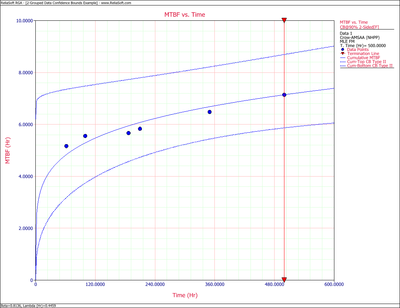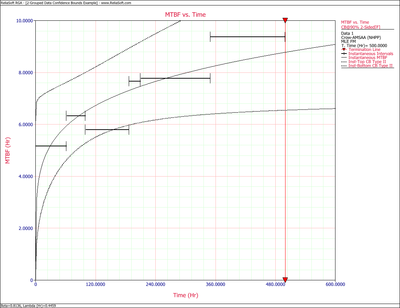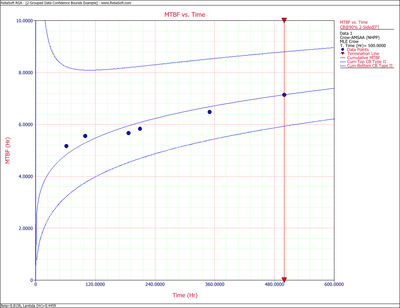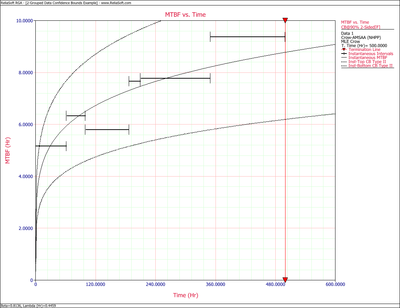Template:Grouped data confidence bounds camsaa
Grouped Data Confidence Bounds
Bounds on [math]\displaystyle{ \beta }[/math]
Fisher Matrix Bounds
The parameter [math]\displaystyle{ \beta }[/math] must be positive, thus [math]\displaystyle{ \ln \beta }[/math] is treated as being normally distributed as well.
- [math]\displaystyle{ \frac{\ln \hat{\beta }-\ln \beta }{\sqrt{Var(\ln \hat{\beta }})}\ \tilde{\ }\ N(0,1) }[/math]
The approximate confidence bounds are given as:
- [math]\displaystyle{ C{{B}_{\beta }}=\hat{\beta }{{e}^{\pm {{z}_{\alpha }}\sqrt{Var(\hat{\beta })}/\hat{\beta }}} }[/math]
- [math]\displaystyle{ \widehat{\beta } }[/math] can be obtained by [math]\displaystyle{ \underset{i=1}{\overset{K}{\mathop{\sum }}}\,{{n}_{i}}\left( \tfrac{T_{i}^{{\hat{\beta }}}\ln {{T}_{i}}-T_{i-1}^{{\hat{\beta }}}\ln \,{{T}_{i-1}}}{T_{i}^{{\hat{\beta }}}-T_{i-1}^{{\hat{\beta }}}}-\ln {{T}_{k}} \right)=0 }[/math] .
All variance can be calculated using the Fisher Matrix:
- [math]\displaystyle{ \left[ \begin{matrix} -\tfrac{{{\partial }^{2}}\Lambda }{\partial {{\lambda }^{2}}} & -\tfrac{{{\partial }^{2}}\Lambda }{\partial \lambda \partial \beta } \\ -\tfrac{{{\partial }^{2}}\Lambda }{\partial \lambda \partial \beta } & -\tfrac{{{\partial }^{2}}\Lambda }{\partial {{\beta }^{2}}} \\ \end{matrix} \right]_{\beta =\widehat{\beta },\lambda =\widehat{\lambda }}^{-1}=\left[ \begin{matrix} Var(\widehat{\lambda }) & Cov(\widehat{\beta },\widehat{\lambda }) \\ Cov(\widehat{\beta },\widehat{\lambda }) & Var(\widehat{\beta }) \\ \end{matrix} \right] }[/math]
[math]\displaystyle{ \Lambda }[/math] is the natural log-likelihood function where ln [math]\displaystyle{ ^{2}T={{\left( \ln T \right)}^{2}} }[/math] and:
- [math]\displaystyle{ \Lambda =\underset{i=1}{\overset{k}{\mathop \sum }}\,\left[ {{n}_{i}}\ln (\lambda T_{i}^{\beta }-\lambda T_{i-1}^{\beta })-(\lambda T_{i}^{\beta }-\lambda T_{i-1}^{\beta })-\ln {{n}_{i}}! \right] }[/math]
- [math]\displaystyle{ \begin{align} & \frac{{{\partial }^{2}}\Lambda }{\partial {{\lambda }^{2}}}= & -\frac{n}{{{\lambda }^{2}}} \\ & \frac{{{\partial }^{2}}\Lambda }{\partial {{\beta }^{2}}}= & \underset{i=1}{\overset{k}{\mathop \sum }}\,\left[ \begin{matrix} {{n}_{i}}\left( \tfrac{(T_{i}^{{\hat{\beta }}}{{\ln }^{2}}{{T}_{i}}-T_{i-1}^{{\hat{\beta }}}{{\ln }^{2}}{{T}_{i-1}})(T_{i}^{{\hat{\beta }}}-T_{i-1}^{{\hat{\beta }}})-{{\left( T_{i}^{{\hat{\beta }}}\ln {{T}_{i}}-T_{i-1}^{{\hat{\beta }}}\ln {{T}_{i-1}} \right)}^{2}}}{{{(T_{i}^{{\hat{\beta }}}-T_{i-1}^{{\hat{\beta }}})}^{2}}} \right) \\ -\left( \lambda T_{i}^{{\hat{\beta }}}{{\ln }^{2}}{{T}_{i}}-\lambda T_{i-1}^{{\hat{\beta }}}{{\ln }^{2}}{{T}_{i-1}} \right) \\ \end{matrix} \right] \\ & \frac{{{\partial }^{2}}\Lambda }{\partial \lambda \partial \beta }= & -T_{K}^{\beta }\ln {{T}_{k}} \end{align} }[/math]
Crow Bounds
- Step 1: Calculate [math]\displaystyle{ P(i)=\tfrac{{{T}_{i}}}{{{T}_{K}}},\,\,i=1,2,\ldots ,K }[/math] .
- Step 2: Calculate:
- [math]\displaystyle{ A=\underset{i=1}{\overset{K}{\mathop \sum }}\,\frac{{{[P{{(i)}^{{\hat{\beta }}}}\ln P{{(i)}^{{\hat{\beta }}}}-P{{(i-1)}^{\widehat{\beta }}}\ln P{{(i-1)}^{{\hat{\beta }}}}]}^{2}}}{[P{{(i)}^{{\hat{\beta }}}}-P{{(i-1)}^{{\hat{\beta }}}}]} }[/math]
- Step 3: Calculate [math]\displaystyle{ c=\tfrac{1}{\sqrt{A}} }[/math] and [math]\displaystyle{ S=\tfrac{({{z}_{1-\alpha /2}})\cdot C}{\sqrt{N}} }[/math] . Thus an approximate 2-sided [math]\displaystyle{ (1-\alpha ) }[/math] 100-percent confidence interval on [math]\displaystyle{ \widehat{\beta } }[/math] is:
Bounds on [math]\displaystyle{ \lambda }[/math]
Fisher Matrix Bounds
The parameter [math]\displaystyle{ \lambda }[/math] must be positive, thus [math]\displaystyle{ \ln \lambda }[/math] is treated as being normally distributed as well. These bounds are based on:
- [math]\displaystyle{ \frac{\ln \hat{\lambda }-\ln \lambda }{\sqrt{Var(\ln \hat{\lambda }})}\ \tilde{\ }\ \lt math\gt \hat{\beta }(1\pm S) }[/math]
- [math]\displaystyle{ N(0,1) }[/math]
The approximate confidence bounds on [math]\displaystyle{ \lambda }[/math] are given as:
- [math]\displaystyle{ C{{B}_{\lambda }}=\hat{\lambda }{{e}^{\pm {{z}_{\alpha }}\sqrt{Var(\hat{\lambda })}/\hat{\lambda }}} }[/math]
- where:
- [math]\displaystyle{ \hat{\lambda }=\frac{n}{T_{k}^{{\hat{\beta }}}} }[/math]
The variance calculation is the same as Eqn. (variances).
Crow Bounds
Time Terminated Data
For the 2-sided [math]\displaystyle{ (1-\alpha ) }[/math] 100-percent confidence interval, the confidence bounds on [math]\displaystyle{ \lambda }[/math] are:
- [math]\displaystyle{ \begin{align} & {{\lambda }_{L}}= & \frac{\chi _{\tfrac{\alpha }{2},2N}^{2}}{2\cdot T_{k}^{\beta }} \\ & {{\lambda }_{U}}= & \frac{\chi _{1-\tfrac{\alpha }{2},2N+2}^{2}}{2\cdot T_{k}^{\beta }} \end{align} }[/math]
Failure Terminated Data
For the 2-sided [math]\displaystyle{ (1-\alpha ) }[/math] 100-percent confidence interval, the confidence bounds on [math]\displaystyle{ \lambda }[/math] are:
- [math]\displaystyle{ \begin{align} & {{\lambda }_{L}}= & \frac{\chi _{\tfrac{\alpha }{2},2N}^{2}}{2\cdot T_{k}^{\beta }} \\ & {{\lambda }_{U}}= & \frac{\chi _{1-\tfrac{\alpha }{2},2N}^{2}}{2\cdot T_{k}^{\beta }} \end{align} }[/math]
Bounds on Growth Rate
Fisher Matrix Bounds
Since the growth rate is equal to [math]\displaystyle{ 1-\beta }[/math] , the confidence bounds are calculated from:
- [math]\displaystyle{ \begin{align} & G\operatorname{row}th\text{ }Rat{{e}_{L}}= & 1-{{\beta }_{U}} \\ & G\operatorname{row}th\text{ }Rat{{e}_{U}}= & 1-{{\beta }_{L}} \end{align} }[/math]
For the Fisher Matrix confidence bounds, [math]\displaystyle{ {{\beta }_{L}} }[/math] and [math]\displaystyle{ {{\beta }_{U}} }[/math] are obtained from Eqn. (Gcbb). For the Crow bounds, [math]\displaystyle{ {{\beta }_{L}} }[/math] and [math]\displaystyle{ {{\beta }_{U}} }[/math] are obtained from Eqn. (gcbb).
Bounds on Cumulative MTBF
Fisher Matrix Bounds
The cumulative MTBF, [math]\displaystyle{ {{m}_{c}}(t) }[/math] , must be positive, thus [math]\displaystyle{ \ln {{m}_{c}}(t) }[/math] is treated as being normally distributed as well.
- [math]\displaystyle{ \frac{\ln {{{\hat{m}}}_{c}}(t)-\ln {{m}_{c}}(t)}{\sqrt{Var(\ln {{{\hat{m}}}_{c}}(t)})}\ \tilde{\ }\ N(0,1) }[/math]
The approximate confidence bounds on the cumulative MTBF are then estimated from:
- [math]\displaystyle{ CB={{\hat{m}}_{c}}(t){{e}^{\pm {{z}_{\alpha }}\sqrt{Var({{{\hat{m}}}_{c}}(t))}/{{{\hat{m}}}_{c}}(t)}} }[/math]
- where:
- [math]\displaystyle{ {{\hat{m}}_{c}}(t)=\frac{1}{{\hat{\lambda }}}{{t}^{1-\hat{\beta }}} }[/math]
- [math]\displaystyle{ \begin{align} & Var({{{\hat{m}}}_{c}}(t))= & {{\left( \frac{\partial {{m}_{c}}(t)}{\partial \beta } \right)}^{2}}Var(\hat{\beta })+{{\left( \frac{\partial {{m}_{c}}(t)}{\partial \lambda } \right)}^{2}}Var(\hat{\lambda }) \\ & & +2\left( \frac{\partial {{m}_{c}}(t)}{\partial \beta } \right)\left( \frac{\partial {{m}_{c}}(t)}{\partial \lambda } \right)cov(\hat{\beta },\hat{\lambda })\, \end{align} }[/math]
The variance calculation is the same as Eqn. (variances) and:
- [math]\displaystyle{ \begin{align} & \frac{\partial {{m}_{c}}(t)}{\partial \beta }= & -\frac{1}{{\hat{\lambda }}}{{t}^{1-\hat{\beta }}}\ln t \\ & \frac{\partial {{m}_{c}}(t)}{\partial \lambda }= & -\frac{1}{{{{\hat{\lambda }}}^{2}}}{{t}^{1-\hat{\beta }}} \end{align} }[/math]
Crow Bounds
Calculate the Crow cumulative failure intensity confidence bounds:
- [math]\displaystyle{ C{{(t)}_{L}}=\frac{\chi _{\tfrac{\alpha }{2},2N}^{2}}{2\cdot t} }[/math]
- [math]\displaystyle{ C{{(t)}_{U}}=\frac{\chi _{1-\tfrac{\alpha }{2},2N+2}^{2}}{2\cdot t} }[/math]
- Then:
- [math]\displaystyle{ \begin{align} & {{[MTB{{F}_{c}}]}_{L}}= & \frac{1}{C{{(t)}_{U}}} \\ & {{[MTB{{F}_{c}}]}_{U}}= & \frac{1}{C{{(t)}_{L}}} \end{align} }[/math]
Bounds on Instantaneous MTBF
Fisher Matrix Bounds
The instantaneous MTBF, [math]\displaystyle{ {{m}_{i}}(t) }[/math] , must be positive, thus [math]\displaystyle{ \ln {{m}_{i}}(t) }[/math] is approximately treated as being normally distributed as well.
- [math]\displaystyle{ \frac{\ln {{{\hat{m}}}_{i}}(t)-\ln {{m}_{i}}(t)}{\sqrt{Var(\ln {{{\hat{m}}}_{i}}(t)})}\ \tilde{\ }\ N(0,1) }[/math]
The approximate confidence bounds on the instantaneous MTBF are then estimated from:
- [math]\displaystyle{ CB={{\hat{m}}_{i}}(t){{e}^{\pm {{z}_{\alpha }}\sqrt{Var({{{\hat{m}}}_{i}}(t))}/{{{\hat{m}}}_{i}}(t)}} }[/math]
- where:
- [math]\displaystyle{ {{\hat{m}}_{i}}(t)=\frac{1}{\lambda \beta {{t}^{\beta -1}}} }[/math]
- [math]\displaystyle{ \begin{align} & Var({{{\hat{m}}}_{i}}(t))= & {{\left( \frac{\partial {{m}_{i}}(t)}{\partial \beta } \right)}^{2}}Var(\hat{\beta })+{{\left( \frac{\partial {{m}_{i}}(t)}{\partial \lambda } \right)}^{2}}Var(\hat{\lambda }) \\ & & +2\left( \frac{\partial {{m}_{i}}(t)}{\partial \beta } \right)\left( \frac{\partial {{m}_{i}}(t)}{\partial \lambda } \right)cov(\hat{\beta },\,\,\,\hat{\lambda }) \end{align} }[/math]
The variance calculation is the same as Eqn. (variances) and:
- [math]\displaystyle{ \begin{align} & \frac{\partial {{m}_{i}}(t)}{\partial \beta }= & -\frac{1}{\hat{\lambda }{{{\hat{\beta }}}^{2}}}{{t}^{1-\hat{\beta }}}-\frac{1}{\hat{\lambda }\hat{\beta }}{{t}^{1-\hat{\beta }}}\ln t \\ & \frac{\partial {{m}_{i}}(t)}{\partial \lambda }= & -\frac{1}{{{{\hat{\lambda }}}^{2}}\hat{\beta }}{{t}^{1-\hat{\beta }}} \end{align} }[/math]
Crow Bounds
- Step 1: Calculate [math]\displaystyle{ P(i)=\tfrac{{{T}_{i}}}{{{T}_{K}}},\,\,i=1,2,\ldots ,K }[/math] .
- Step 2: Calculate:
- [math]\displaystyle{ A=\underset{i=1}{\overset{K}{\mathop \sum }}\,\frac{{{\left[ P{{(i)}^{{\hat{\beta }}}}\ln P{{(i)}^{{\hat{\beta }}}}-P{{(i-1)}^{\widehat{\beta }}}\ln P{{(i-1)}^{{\hat{\beta }}}} \right]}^{2}}}{\left[ P{{(i)}^{{\hat{\beta }}}}-P{{(i-1)}^{{\hat{\beta }}}} \right]} }[/math]
- Step 3: Calculate [math]\displaystyle{ D=\sqrt{\tfrac{1}{A}+1} }[/math] and [math]\displaystyle{ W=\tfrac{({{z}_{1-\alpha /2}})\cdot D}{\sqrt{N}} }[/math] . Thus an approximate 2-sided [math]\displaystyle{ (1-\alpha ) }[/math] 100-percent confidence interval on [math]\displaystyle{ {{\hat{m}}_{i}}(t) }[/math] is:
- [math]\displaystyle{ MTB{{F}_{i}}={{\widehat{m}}_{i}}(1\pm W) }[/math]
Bounds on Cumulative Failure Intensity
Fisher Matrix Bounds
The cumulative failure intensity, [math]\displaystyle{ {{\lambda }_{c}}(t) }[/math] , must be positive, thus [math]\displaystyle{ \ln {{\lambda }_{c}}(t) }[/math] is treated as being normally distributed.
- [math]\displaystyle{ \frac{\ln {{{\hat{\lambda }}}_{c}}(t)-\ln {{\lambda }_{c}}(t)}{\sqrt{Var(\ln {{{\hat{\lambda }}}_{c}}(t)})}\ \tilde{\ }\ N(0,1) }[/math]
The approximate confidence bounds on the cumulative failure intensity are then estimated from:
- [math]\displaystyle{ CB={{\hat{\lambda }}_{c}}(t){{e}^{\pm {{z}_{\alpha }}\sqrt{Var({{{\hat{\lambda }}}_{c}}(t))}/{{{\hat{\lambda }}}_{c}}(t)}} }[/math]
- where:
- [math]\displaystyle{ {{\hat{\lambda }}_{c}}(t)=\hat{\lambda }{{t}^{\hat{\beta }-1}} }[/math]
- and:
- [math]\displaystyle{ \begin{align} & Var({{{\hat{\lambda }}}_{c}}(t))= & {{\left( \frac{\partial {{\lambda }_{c}}(t)}{\partial \beta } \right)}^{2}}Var(\hat{\beta })+{{\left( \frac{\partial {{\lambda }_{c}}(t)}{\partial \lambda } \right)}^{2}}Var(\hat{\lambda }) \\ & & +2\left( \frac{\partial {{\lambda }_{c}}(t)}{\partial \beta } \right)\left( \frac{\partial {{\lambda }_{c}}(t)}{\partial \lambda } \right)cov(\hat{\beta },\,\,\,\hat{\lambda }) \end{align} }[/math]
The variance calculation is the same as Eqn. (variances) and:
- [math]\displaystyle{ \begin{align} & \frac{\partial {{\lambda }_{c}}(t)}{\partial \beta }= & \hat{\lambda }{{t}^{\hat{\beta }-1}}\ln t \\ & \frac{\partial {{\lambda }_{c}}(t)}{\partial \lambda }= & {{t}^{\hat{\beta }-1}} \end{align} }[/math]
Crow Bounds
The Crow cumulative failure intensity confidence bounds are given as:
- [math]\displaystyle{ \begin{align} & C{{(t)}_{L}}= & \frac{\chi _{\tfrac{\alpha }{2},2N}^{2}}{2\cdot t} \\ & C{{(t)}_{U}}= & \frac{\chi _{1-\tfrac{\alpha }{2},2N+2}^{2}}{2\cdot t} \end{align} }[/math]
Bounds on Instantaneous Failure Intensity
Fisher Matrix Bounds
The instantaneous failure intensity, [math]\displaystyle{ {{\lambda }_{i}}(t) }[/math] , must be positive, thus [math]\displaystyle{ \ln {{\lambda }_{i}}(t) }[/math] is treated as being normally distributed.
- [math]\displaystyle{ \frac{\ln {{{\hat{\lambda }}}_{i}}(t)-\ln {{\lambda }_{i}}(t)}{\sqrt{Var(\ln {{{\hat{\lambda }}}_{i}}(t)})}\tilde{\ }N(0,1) }[/math]
The approximate confidence bounds on the instantaneous failure intensity are then estimated from:
- [math]\displaystyle{ CB={{\hat{\lambda }}_{i}}(t){{e}^{\pm {{z}_{\alpha }}\sqrt{Var({{{\hat{\lambda }}}_{i}}(t))}/{{{\hat{\lambda }}}_{i}}(t)}} }[/math]
where [math]\displaystyle{ {{\lambda }_{i}}(t)=\lambda \beta {{t}^{\beta -1}} }[/math] and:
- [math]\displaystyle{ \begin{align} & Var({{{\hat{\lambda }}}_{i}}(t))= & {{\left( \frac{\partial {{\lambda }_{i}}(t)}{\partial \beta } \right)}^{2}}Var(\hat{\beta })+{{\left( \frac{\partial {{\lambda }_{i}}(t)}{\partial \lambda } \right)}^{2}}Var(\hat{\lambda }) \\ & & +2\left( \frac{\partial {{\lambda }_{i}}(t)}{\partial \beta } \right)\left( \frac{\partial {{\lambda }_{i}}(t)}{\partial \lambda } \right)cov(\hat{\beta },\,\,\,\hat{\lambda }) \end{align} }[/math]
The variance calculation is the same as Eqn. (variances) and:
- [math]\displaystyle{ \begin{align} & \frac{\partial {{\lambda }_{i}}(t)}{\partial \beta }= & \hat{\lambda }{{t}^{\hat{\beta }-1}}+\hat{\lambda }\hat{\beta }{{t}^{\hat{\beta }-1}}\ln t \\ & \frac{\partial {{\lambda }_{i}}(t)}{\partial \lambda }= & \hat{\beta }{{t}^{\hat{\beta }-1}} \end{align} }[/math]
Crow Bounds
The Crow instantaneous failure intensity confidence bounds are given as:
- [math]\displaystyle{ \begin{align} & {{[{{\lambda }_{i}}(t)]}_{L}}= & \frac{1}{{{[MTB{{F}_{i}}]}_{U}}} \\ & {{[{{\lambda }_{i}}(t)]}_{U}}= & \frac{1}{{{[MTB{{F}_{i}}]}_{L}}} \end{align} }[/math]
Bounds on Time Given Cumulative MTBF
Fisher Matrix Bounds
The time, [math]\displaystyle{ T }[/math] , must be positive, thus [math]\displaystyle{ \ln T }[/math] is treated as being normally distributed.
- [math]\displaystyle{ \frac{\ln \hat{T}-\ln T}{\sqrt{Var(\ln \hat{T}})}\ \tilde{\ }\ N(0,1) }[/math]
Confidence bounds on the time are given by:
- [math]\displaystyle{ CB=\hat{T}{{e}^{\pm {{z}_{\alpha }}\sqrt{Var(\hat{T})}/\hat{T}}} }[/math]
- where:
- [math]\displaystyle{ \begin{align} & Var(\hat{T})= & {{\left( \frac{\partial T}{\partial \beta } \right)}^{2}}Var(\hat{\beta })+{{\left( \frac{\partial T}{\partial \lambda } \right)}^{2}}Var(\hat{\lambda }) \\ & & +2\left( \frac{\partial T}{\partial \beta } \right)\left( \frac{\partial T}{\partial \lambda } \right)cov(\hat{\beta },\,\,\,\hat{\lambda }) \end{align} }[/math]
The variance calculation is the same as Eqn. (variances) and:
- [math]\displaystyle{ \hat{T}={{(\lambda \cdot {{m}_{c}})}^{1/(1-\beta )}} }[/math]
- [math]\displaystyle{ \begin{align} & \frac{\partial T}{\partial \beta }= & \frac{{{(\lambda \cdot \,{{m}_{c}})}^{1/(1-\beta )}}\ln (\lambda \cdot \text{ }{{m}_{c}})}{{{(1-\beta )}^{2}}} \\ & \frac{\partial T}{\partial \lambda }= & \frac{{{(\lambda \cdot {{m}_{c}})}^{1/(1-\beta )}}}{\lambda (1-\beta )} \end{align} }[/math]
Crow Bounds
- Step 1: Calculate [math]\displaystyle{ {{\lambda }_{c}}(T)=\tfrac{1}{MTB{{F}_{c}}} }[/math] .
- Step 2: Use equations in 5.4.10.1 to calculate the bounds on time given the cumulative failure intensity.
Bounds on Time Given Instantaneous MTBF
Fisher Matrix Bounds
The time, [math]\displaystyle{ T }[/math] , must be positive, thus [math]\displaystyle{ \ln T }[/math] is treated as being normally distributed.
- [math]\displaystyle{ \frac{\ln \hat{T}-\ln T}{\sqrt{Var(\ln \hat{T}})}\ \tilde{\ }\ N(0,1) }[/math]
Confidence bounds on the time are given by:
- [math]\displaystyle{ CB=\hat{T}{{e}^{\pm {{z}_{\alpha }}\sqrt{Var(\hat{T})}/\hat{T}}} }[/math]
- where:
- [math]\displaystyle{ \begin{align} & Var(\hat{T})= & {{\left( \frac{\partial T}{\partial \beta } \right)}^{2}}Var(\hat{\beta })+{{\left( \frac{\partial T}{\partial \lambda } \right)}^{2}}Var(\hat{\lambda }) \\ & & +2\left( \frac{\partial T}{\partial \beta } \right)\left( \frac{\partial T}{\partial \lambda } \right)cov(\hat{\beta },\,\,\,\hat{\lambda }) \end{align} }[/math]
The variance calculation is the same as Eqn. (variances) and:
- [math]\displaystyle{ \hat{T}={{(\lambda \beta \cdot {{m}_{i}}(T))}^{1/(1-\beta )}} }[/math]
- [math]\displaystyle{ \begin{align} & \frac{\partial T}{\partial \beta }= & {{\left( \lambda \beta \cdot \text{ }{{m}_{i}}(T) \right)}^{1/(1-\beta )}}\left[ \frac{1}{{{(1-\beta )}^{2}}}\ln (\lambda \beta \cdot {{m}_{i}}(T))+\frac{1}{\beta (1-\beta )} \right] \\ & \frac{\partial T}{\partial \lambda }= & \frac{{{(\lambda \beta \cdot \text{ }{{m}_{i}}(T))}^{1/(1-\beta )}}}{\lambda (1-\beta )} \end{align} }[/math]
Crow Bounds
- Step 1: Calculate the confidence bounds on the instantaneous MTBF:
- [math]\displaystyle{ MTB{{F}_{i}}={{\widehat{m}}_{i}}(1\pm W) }[/math]
- Step 2: Use equations in 5.4.5.2 to calculate the time given the instantaneous MTBF.
Bounds on Time Given Cumulative Failure Intensity
Fisher Matrix Bounds
The time, [math]\displaystyle{ T }[/math] , must be positive, thus [math]\displaystyle{ \ln T }[/math] is treated as being normally distributed.
- [math]\displaystyle{ \frac{\ln \hat{T}-\ln T}{\sqrt{Var(\ln \hat{T}})}\ \tilde{\ }\ N(0,1) }[/math]
Confidence bounds on the time are given by:
- [math]\displaystyle{ CB=\hat{T}{{e}^{\pm {{z}_{\alpha }}\sqrt{Var(\hat{T})}/\hat{T}}} }[/math]
- where:
- [math]\displaystyle{ \begin{align} & Var(\hat{T})= & {{\left( \frac{\partial T}{\partial \beta } \right)}^{2}}Var(\hat{\beta })+{{\left( \frac{\partial T}{\partial \lambda } \right)}^{2}}Var(\hat{\lambda }) \\ & & +2\left( \frac{\partial T}{\partial \beta } \right)\left( \frac{\partial T}{\partial \lambda } \right)cov(\hat{\beta },\,\,\,\hat{\lambda }) \end{align} }[/math]
The variance calculation is the same as Eqn. (variances) and:
- [math]\displaystyle{ \begin{align} & \frac{\partial T}{\partial \beta }= & \frac{-{{\left( \tfrac{{{\lambda }_{c}}(T)}{\lambda } \right)}^{1/(\beta -1)}}\ln \left( \tfrac{{{\lambda }_{c}}(T)}{\lambda } \right)}{{{(1-\beta )}^{2}}} \\ & \frac{\partial T}{\partial \lambda }= & {{\left( \frac{{{\lambda }_{c}}(T)}{\lambda } \right)}^{1/(\beta -1)}}\frac{1}{\lambda (1-\beta )} \end{align} }[/math]
Crow Bounds
- Step 1: Calculate:
- [math]\displaystyle{ \hat{T}={{\left( \frac{{{\lambda }_{c}}(T)}{{\hat{\lambda }}} \right)}^{\tfrac{1}{\beta -1}}} }[/math]
- Step 2: Estimate the number of failures:
- [math]\displaystyle{ N(\hat{T})=\hat{\lambda }{{\hat{T}}^{{\hat{\beta }}}} }[/math]
- Step 3: Obtain the confidence bounds on time given the cumulative failure intensity by solving for [math]\displaystyle{ {{t}_{l}} }[/math] and [math]\displaystyle{ {{t}_{u}} }[/math] in the following equations:
- [math]\displaystyle{ \begin{align} & {{t}_{l}}= & \frac{\chi _{\tfrac{\alpha }{2},2N}^{2}}{2\cdot {{\lambda }_{c}}(T)} \\ & {{t}_{u}}= & \frac{\chi _{1-\tfrac{\alpha }{2},2N+2}^{2}}{2\cdot {{\lambda }_{c}}(T)} \end{align} }[/math]
Bounds on Time Given Instantaneous Failure Intensity
Fisher Matrix Bounds
The time, [math]\displaystyle{ T }[/math] , must be positive, thus [math]\displaystyle{ \ln T }[/math] is treated as being normally distributed.
- [math]\displaystyle{ \frac{\ln \hat{T}-\ln T}{\sqrt{Var(\ln \hat{T}})}\ \tilde{\ }\ N(0,1) }[/math]
Confidence bounds on the time are given by:
- [math]\displaystyle{ CB=\hat{T}{{e}^{\pm {{z}_{\alpha }}\sqrt{Var(\hat{T})}/\hat{T}}} }[/math]
- where:
- [math]\displaystyle{ \begin{align} & Var(\hat{T})= & {{\left( \frac{\partial T}{\partial \beta } \right)}^{2}}Var(\hat{\beta })+{{\left( \frac{\partial T}{\partial \lambda } \right)}^{2}}Var(\hat{\lambda }) \\ & & +2\left( \frac{\partial T}{\partial \beta } \right)\left( \frac{\partial T}{\partial \lambda } \right)cov(\hat{\beta },\,\,\,\hat{\lambda }) \end{align} }[/math]
The variance calculation is the same as Eqn. (variances) and:
- [math]\displaystyle{ \hat{T}={{\left( \frac{{{\lambda }_{i}}(T)}{\lambda \beta } \right)}^{1/(\beta -1)}} }[/math]
- [math]\displaystyle{ \begin{align} & \frac{\partial T}{\partial \beta }= & {{\left( \frac{{{\lambda }_{i}}(T)}{\lambda \beta } \right)}^{1/(\beta -1)}}\left[ -\frac{\ln (\tfrac{{{\lambda }_{i}}(T)}{\lambda \beta })}{{{(\beta -1)}^{2}}}+\frac{1}{\beta (1-\beta )} \right] \\ & \frac{\partial T}{\partial \lambda }= & {{\left( \frac{{{\lambda }_{i}}(T)}{\lambda \beta } \right)}^{1/(\beta -1)}}\frac{1}{\lambda (1-\beta )} \end{align} }[/math]
Crow Bounds
- Step 1: Calculate [math]\displaystyle{ MTB{{F}_{i}}=\tfrac{1}{{{\lambda }_{i}}(T)} }[/math] .
- Step 2: Follow the same process as in 5.4.9.2 to calculate the bounds on time given the instantaneous failure intensity.
Bounds on Cumulative Number of Failures
Fisher Matrix Bounds
The cumulative number of failures, [math]\displaystyle{ N(t) }[/math] , must be positive, thus [math]\displaystyle{ \ln N(t) }[/math] is treated as being normally distributed.
- [math]\displaystyle{ \frac{\ln \hat{N}(t)-\ln N(t)}{\sqrt{Var(\ln \hat{N}(t)})}\ \tilde{\ }\ N(0,1) }[/math]
- [math]\displaystyle{ N(t)=\hat{N}(t){{e}^{\pm {{z}_{\alpha }}\sqrt{Var(\hat{N}(t))}/\hat{N}(t)}} }[/math]
- where:
- [math]\displaystyle{ \hat{N}(t)=\hat{\lambda }{{t}^{{\hat{\beta }}}} }[/math]
- [math]\displaystyle{ \begin{align} & Var(\hat{N}(t))= & {{\left( \frac{\partial \hat{N}(t)}{\partial \beta } \right)}^{2}}Var(\hat{\beta })+{{\left( \frac{\partial \hat{N}(t)}{\partial \lambda } \right)}^{2}}Var(\hat{\lambda }) \\ & & +2\left( \frac{\partial \hat{N}(t)}{\partial \beta } \right)\left( \frac{\partial \hat{N}(t)}{\partial \lambda } \right)cov(\hat{\beta },\hat{\lambda }) \end{align} }[/math]
The variance calculation is the same as Eqn. (variances) and:
- [math]\displaystyle{ \begin{align} & \frac{\partial \hat{N}(t)}{\partial \beta }= & \hat{\lambda }{{t}^{{\hat{\beta }}}}\ln t \\ & \frac{\partial \hat{N}(t)}{\partial \lambda }= & {{t}^{{\hat{\beta }}}} \end{align} }[/math]
Crow Bounds
The Crow confidence bounds on cumulative number of failures are:
- [math]\displaystyle{ \begin{align} & {{N}_{L}}(T)= & \frac{T}{{\hat{\beta }}}{{\lambda }_{i}}{{(T)}_{L}} \\ & {{N}_{U}}(T)= & \frac{T}{{\hat{\beta }}}{{\lambda }_{i}}{{(T)}_{U}} \end{align} }[/math]
where [math]\displaystyle{ {{\lambda }_{i}}{{(T)}_{L}} }[/math] and [math]\displaystyle{ {{\lambda }_{i}}{{(T)}_{U}} }[/math] can be obtained from Eqn. (dsaf).
Example 5
A new helicopter system is under development. System failure data has been collected on five helicopters during the final test phase. The actual failure times cannot be determined since the failures are not discovered until after the helicopters are brought into the maintenance area. However, total flying hours are known when the helicopters are brought in for service and every two weeks, each helicopter undergoes a thorough inspection to uncover any failures that may have occurred since the last inspection. Therefore, the cumulative total number of flight hours and the cumulative total number of failures for the five helicopters are known for each two-week period. The total number of flight hours from the test phase is 500, which was accrued over a period of 12 weeks (6 2-week intervals). For each 2-week interval, the total number of flight hours and total number of failures for the five helicopters were recorded. The grouped data set is displayed in Table 5.3.
| Interval | Interval Length | Failures in Interval |
|---|---|---|
| 1 | 0 - 62 | 12 |
| 2 | 62 -100 | 6 |
| 3 | 100 - 187 | 15 |
| 4 | 187 - 210 | 3 |
| 5 | 210 - 350 | 18 |
| 6 | 350 - 500 | 16 |
- 1) Estimate the parameters of the Crow-AMSAA model using maximum likelihood estimation.
- 2) Calculate the confidence bounds on the cumulative and instantaneous MTBF using the
Fisher Matrix and Crow methods.
Solution
- 1) Obtain the estimator of [math]\displaystyle{ \beta }[/math] using Eqn. (vv). Using RGA, the value of [math]\displaystyle{ \widehat{\beta } }[/math] is 0.81361. Now plug this value into Eqn. (vv1) and [math]\displaystyle{ \widehat{\lambda } }[/math] is:
- [math]\displaystyle{ \widehat{\lambda }=0.44585 }[/math]
Fisher Matrix confidence bounds can be obtained on the parameters [math]\displaystyle{ \widehat{\beta } }[/math] and [math]\displaystyle{ \widehat{\lambda } }[/math] at the 90% confidence level by:
- [math]\displaystyle{ \begin{align} & {{\beta }_{L}}= & \hat{\beta }{{e}^{{{z}_{\alpha }}\sqrt{Var(\hat{\beta })}/\hat{\beta }}} \\ & = & 0.6546 \\ & {{\beta }_{U}}= & \hat{\beta }{{e}^{-{{z}_{\alpha }}\sqrt{Var(\hat{\beta })}/\hat{\beta }}} \\ & = & 1.0112 \end{align} }[/math]
- and:
- [math]\displaystyle{ \begin{align} & {{\lambda }_{L}}= & \hat{\lambda }{{e}^{{{z}_{\alpha }}\sqrt{Var(\hat{\lambda })}/\hat{\lambda }}} \\ & = & 0.14594 \\ & {{\lambda }_{U}}= & \hat{\lambda }{{e}^{-{{z}_{\alpha }}\sqrt{Var(\hat{\lambda })}/\hat{\lambda }}} \\ & = & 1.36207 \end{align} }[/math]
Crow confidence bounds can also be obtained on the parameters [math]\displaystyle{ \widehat{\beta } }[/math] and [math]\displaystyle{ \widehat{\lambda } }[/math] at the 90% confidence level, as:
- [math]\displaystyle{ \begin{align} & {{\beta }_{L}}= & \hat{\beta }(1-S) \\ & = & 0.63552 \\ & {{\beta }_{U}}= & \hat{\beta }(1+S) \\ & = & 0.99170 \end{align} }[/math]
- and:
- [math]\displaystyle{ \begin{align} & {{\lambda }_{L}}= & \frac{\chi _{\tfrac{\alpha }{2},2N}^{2}}{2\cdot T_{k}^{\beta }} \\ & = & 0.36197 \\ & {{\lambda }_{U}}= & \frac{\chi _{1-\tfrac{\alpha }{2},2N+2}^{2}}{2\cdot T_{k}^{\beta }} \\ & = & 0.53697 \end{align} }[/math]
- 2) The Fisher Matrix confidence bounds for the cumulative MTBF and the instantaneous MTBF at the 90% 2-sided confidence level and for [math]\displaystyle{ T=500 }[/math] hr are:
- [math]\displaystyle{ \begin{align} & {{[{{m}_{c}}(T)]}_{L}}= & {{{\hat{m}}}_{c}}(t){{e}^{{{z}_{\alpha /2}}\sqrt{Var({{{\hat{m}}}_{c}}(t))}/{{{\hat{m}}}_{c}}(t)}} \\ & = & 5.8680 \\ & {{[{{m}_{c}}(T)]}_{U}}= & {{{\hat{m}}}_{c}}(t){{e}^{-{{z}_{\alpha /2}}\sqrt{Var({{{\hat{m}}}_{c}}(t))}/{{{\hat{m}}}_{c}}(t)}} \\ & = & 8.6947 \end{align} }[/math]
- and:
- [math]\displaystyle{ \begin{align} & {{[MTB{{F}_{i}}]}_{L}}= & {{{\hat{m}}}_{i}}(t){{e}^{{{z}_{\alpha /2}}\sqrt{Var({{{\hat{m}}}_{i}}(t))}/{{{\hat{m}}}_{i}}(t)}} \\ & = & 6.6483 \\ & {{[MTB{{F}_{i}}]}_{U}}= & {{{\hat{m}}}_{i}}(t){{e}^{-{{z}_{\alpha /2}}\sqrt{Var({{{\hat{m}}}_{i}}(t))}/{{{\hat{m}}}_{i}}(t)}} \\ & = & 11.5932 \end{align} }[/math]
Figures 4fig810 and 4fig811 show plots of the Fisher Matrix confidence bounds for the cumulative and instantaneous MTBF.
The Crow confidence bounds for the cumulative and instantaneous MTBF at the 90% 2-sided confidence level and for hours are:
- [math]\displaystyle{ T=500 }[/math]
- [math]\displaystyle{ \begin{align} & {{[{{m}_{c}}(T)]}_{L}}= & \frac{1}{C{{(t)}_{U}}} \\ & = & 5.85449 \\ & {{[{{m}_{c}}(T)]}_{U}}= & \frac{1}{C{{(t)}_{L}}} \\ & = & 8.79822 \end{align} }[/math]
- and:
- [math]\displaystyle{ \begin{align} & {{[MTB{{F}_{i}}]}_{L}}= & {{\widehat{m}}_{i}}(1-W) \\ & = & 6.19623 \\ & {{[MTB{{F}_{i}}]}_{U}}= & {{\widehat{m}}_{i}}(1+W) \\ & = & 11.36223 \end{align} }[/math]
Figures 4fig812 and 4fig813 show plots of the Crow confidence bounds for the cumulative and instantaneous MTBF.



